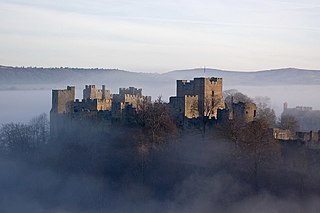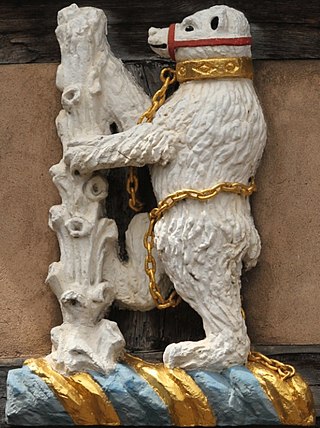Related Research Articles
Spencer is a surname, representing the court title dispenser, or steward. An early example is Robert d'Abbetot, who is listed as Robert le Dispenser, a tenant-in-chief of several counties, in the Domesday Book of 1086. In early times, the surname was usually written as le Despenser, Dispenser or Despencer—notably in works such as the Domesday Book and the Scottish Ragman Rolls of 1291 and 1296, but gradually lost both the "le" article and the unstressed first syllable of the longer surname to become Spencer.
Walter of Gloucester was an early Anglo-Norman official of the King of England during the early years of the Norman conquest of the South Welsh Marches. He was a sheriff of Gloucester and also a Constable under Henry I.

Eudo Dapifer ;, was a Norman aristocrat who served as a steward under William the Conqueror, William II Rufus, and Henry I.
Urse d'Abetot was a Norman who followed King William I to England, and became Sheriff of Worcestershire and a royal official under him and Kings William II and Henry I. He was a native of Normandy and moved to England shortly after the Norman Conquest of England in 1066, and was appointed sheriff in about 1069. Little is known of his family in Normandy, who were not prominent, but he probably got his name from the village Abetot. Although Urse's lord in Normandy was present at the Battle of Hastings, there is no evidence that Urse took part in the invasion of England in 1066.

William de Chesney was an Anglo-Norman magnate during the reign of King Stephen of England and King Henry II of England. Chesney was part of a large family; one of his brothers became Bishop of Lincoln and another Abbot of Evesham Abbey. Stephen may have named him Sheriff of Oxfordshire. Besides his administrative offices, Chesney controlled a number of royal castles, and served Stephen during some of the king's English military campaigns. Chesney's heir was his niece, Matilda, who married Henry fitzGerold.

Robert Despenser was a Norman officeholder and landholder in post-Conquest medieval England.
Roger d'Abetot was a medieval English Sheriff of Worcestershire.
Hamo Dapifer was an Anglo-Norman royal official under both King William I of England and his son King William II of England. He held the office, from which his epithet derives, known in Latin as dapifer and in French seneschal, in English "steward", as well as the office of Sheriff of Kent.
Cyneweard of Laughern or simply Cyneweard was a mid-11th century Anglo-Saxon thegn and sheriff in Worcestershire, England. Probably the son of Æthelric Kiu and grand-nephew of Wulfstan Lupus, Archbishop of York (1003–1023), he was one of the leading nobles of the county at the Norman Conquest of England. On the death of Edward the Confessor he held lands in Gloucestershire and Warwickshire as well as Worcestershire.

Worcester Castle was a Norman fortification built between 1068 and 1069 in Worcester, England by Urse d'Abetot on behalf of William the Conqueror. The castle had a motte-and-bailey design and was located on the south side of the old Anglo-Saxon city, cutting into the grounds of Worcester Cathedral. Royal castles were owned by the king and maintained on his behalf by an appointed constable. At Worcester that role was passed down through the local Beauchamp family on a hereditary basis, giving them permanent control of the castle and considerable power within the city. The castle played an important part in the wars of the 12th and early 13th century, including the Anarchy and the First Barons' War.
Ralph Basset was a medieval English royal justice during the reign of King Henry I of England. He was a native of Normandy, and may have come to Henry's notice while Henry held land in Normandy prior to becoming king. Basset is first mentioned in documents about 1102, and from then until his death around 1127, he was frequently employed as a royal justice. His son Richard Basset also became a royal judge.
Richard Basset was a royal judge and sheriff during the reign of King Henry I of England. His father was also a royal justice. In about 1122 Basset married the eventual heiress of another justice; the marriage settlement has survived. In 1129–30 Basset was co-sheriff of eleven counties. Basset and his wife founded a monastic house in 1125 from their lands, which before the donation were equivalent to 15 knight's fees.

Pain fitzJohn was an Anglo-Norman nobleman and administrator, one of King Henry I of England's "new men", who owed their positions and wealth to the king.

Walter II de Beauchamp, of Elmley Castle in Worcestershire, was hereditary Sheriff of Worcestershire.
William de Chesney was a medieval Anglo-Norman nobleman and sheriff. The son of a landholder in Norfolk, William inherited after the death of his two elder brothers. He was the founder of Sibton Abbey, as well as a benefactor of other monasteries in England. In 1157, Chesney acquired the honour of Blythburgh, and was sheriff of Norfolk and Suffolk during the 1150s and 1160s. On Chesney's death in 1174, he left three unmarried daughters as his heirs.

Walter de Lacy was a Norman nobleman who went to England after the Norman Conquest of England in 1066. He received lands in Herefordshire and Shropshire, and served King William I of England by leading military forces during 1075. He died in 1085 and one son inherited his lands. Another son became an abbot.
William Meschin was an Anglo-Norman nobleman and baron. The brother of the earl of Chester, Meschin participated in the First Crusade. After returning to England, he acquired lands both from King Henry I of England and by his marriage to an heiress.
Adam de Port was an Anglo-Norman nobleman and Baron of Kington.
Hugh de Beauchamp was a Norman who held lands in England after the Norman Conquest.

The Bear and Ragged Staff is a heraldic emblem or badge associated with the Earldom of Warwick.
References
- Barlow, Frank (2000). William Rufus (Second ed.). New Haven, CT: Yale University Press. ISBN 0-300-08291-6.
- Crouch, David (1986). The Beaumont Twins: The Roots & Branches of Power in the Twelfth Century (reprint of 2008 ed.). Cambridge, UK: Cambridge University Press. ISBN 978-0-521-09013-1.
- Doherty, H. F. (2004). "Henry I's new men (act. 1100–1135)". Oxford Dictionary of National Biography. Oxford University Press. doi:10.1093/ref:odnb/95593 . Retrieved 8 September 2018.(subscription or UK public library membership required)
- Green, Judith A. (1997). The Aristocracy of Norman England. Cambridge, UK: Cambridge University Press. ISBN 0-521-52465-2.
- Green, Judith A. (1990). English Sheriffs to 1154. Public Record Office Handbooks Number 24. London: Her Majesty's Stationery Office. ISBN 0-11-440236-1.
- Green, Judith A. (1986). The Government of England Under Henry I. Cambridge, UK: Cambridge University Press. ISBN 0-521-37586-X.
- Hollister, C. Warren (2001). Frost, Amanda Clark (ed.). Henry I. New Haven, CT: Yale University Press. ISBN 0-300-08858-2.
- Keats-Rohan, K. S. B. (1999). Domesday Descendants: A Prosopography of Persons Occurring in English Documents, 1066–1166: Pipe Rolls to Cartae Baronum. Ipswich, UK: Boydell Press. ISBN 0-85115-863-3.
- Keats-Rohan, K. S. B. (1999). Domesday People: A Prosopography of Persons Occurring in English Documents, 1066–1166: Domesday Book. Ipswich, UK: Boydell Press. ISBN 0-85115-722-X.
- Mason, Emma (1980). "Introduction". In Mason, Emma (ed.). The Beauchamp Cartulary Charters 1100–1268. Publications of the Pipe Roll Society New Series XLII. London: Pipe Roll Society.
- Mason, Emma (1984). "Legends of the Beauchamps' Ancestors: The Use of Baronial Propaganda in Medieval England". Journal of Medieval History . 10: 25–40. doi:10.1016/0304-4181(84)90023-X.
- Mason, Emma (2004). "Beauchamp, Walter (I) de (c.1065–1130/31)". Oxford Dictionary of National Biography. Oxford University Press. doi:10.1093/ref:odnb/47246 . Retrieved 24 November 2009.(subscription or UK public library membership required)
- Newman, Charlotte A. (1988). The Anglo-Norman Nobility in the Reign of Henry I: The Second Generation. Philadelphia, PA: University of Pennsylvania Press. ISBN 0-8122-8138-1.